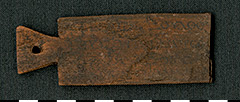SB I 1206 (ÄM 11826)
From the 1st century AD at the latest, it was customary in Egypt to attach small wooden labels to mummies that were inscribed in Greek and/or Demotic. This custom continued to enjoy great popularity in the following centuries. The main purpose of the mummy labels was to identify the embalmed corpses. They gave the name of the deceased, often his or her filiation and an age. Some mummy plaques also contained freight instructions for the mummy, giving information about costs, places of dispatch and destination, and details of transport. Demotic mummy labels also feature religious formulas that are also found on tomb stelae, such as the invocation to the Ba-’soul‘ to be permanently alive. The mummy plaques thus represented a kind of substitute for a gravestone, which would have been too expensive for most people. They belonged exclusively to the deceased of the lower classes.
This small mummy tablet was acquired by Robert Forrer in 1894 for the Berlin Papyrus Collection and probably comes from ancient Panopolis, today’s Achmim. It has the shape of a tabula ansata on the left side. The nose has a hole through which a cord could be pulled to attach the label to the mummy. On the other side it has a straight end. The mummy label is inscribed on one side only. The text was written very carefully in ink, but is poorly preserved. The writing is very close to a book script and can be dated to the 2nd–3rd century AD.
As is usual for all mummy plaques, the text contains the name of the deceased: Epaphrys. The name is a short form of Epaphroditos. It means that the holder is favoured by the goddess of love, Aphrodite. In antiquity, it was mainly slaves or freedmen who bore this name. So it is not surprising that Epaphrys is explicitly described on this label as the slave of an Iulius Isidorus. The latter, in turn, is said to be a philosopher. Such occupational designations can certainly be found on other mummy labels, but they mostly refer to the deceased himself and not to other named persons. A philosopher of this name also appears on a Leiden mummy label (Inv. F 1942/12.15), where it is specified that the mummy of a Sarapion, son of Iulius Hilarion, should be brought to him in Panopolis. Even if a similarity of names is not yet sufficient to equate these two persons with the name Iulius Isidorus, the identical occupational title at least increases the probability and might allow the conclusion that Iulius Isidorus lived in Panopolis.
If this conclusion is correct, the note at the end of the short text on the Berlin mummy plaque becomes interesting. Here it is stated that the mummy of Epaphrys is to be brought to Panopolis. From this note one will now be able to conclude that Epaphrys did not die in Panopolis. Possibly he was travelling on behalf of his master and died on the journey. His body now had to be brought back to Panopolis.
This Mummy Label of a Slave was on display in the special exhibition „Akhmim – Egypt’s Forgotten City“.



